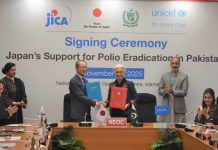Similarly, doctors in Pakistan are also using a number of different approaches to treat COVID-19 patients. A national webinar, Management of Severe COVID Patients, which was hosted by the Indus Hospital demonstrated how the doctors were collaborating across hospitals, cities and provinces to pool their clinical resources.
The panel of experts comprised:
- Dr Faisal Mahmood, head of infectious diseases, Aga Khan University, Karachi
- Dr Samreen Sarfaraz, lead faculty infectious diseases, Indus Hospital, Karachi
- Dr Faisal Sultan, CEO and head of infectious diseases, Shaukat Khanum Memorial Cancer Hospital and Research Centre, Lahore
- Dr Naseem Akhter, assistant professor infectious diseases, PIMS, Islamabad
- Dr Amjad Mehboob, assistant professor and consultant internal medicine, Bacha Khan Medical Complex, Peshawar
- Dr Shobha Luxmi, consultant infectious diseases, DUHS, Karachi
- Dr Asma Naseem, associate professor and head of infectious diseases, SIUT, Karachi
- Dr Nosheen Nasir, consultant infectious diseases, Aga Khan University, Karachi
“There has been no clinical evidence for any successful prophylaxis as of April 15,” said Dr Faisal Mahmood, starting off the discussion on whether any drug could prevent COVID-19. “But as the situation keeps evolving, we might come across new research that changes treatment approaches.”
He warned people about placing too much faith in non-peer reviewed articles or in vitro (in the laboratory) research which doesn’t always translate to better clinical outcomes.
For mild patients there’s no treatment except supportive care, he added, and it’s important to remember that these will be 80% of COVID-19 cases.
Here’s what the doctors in Pakistan have tried so far and what’s worked
Chloroquine and hydroxychloroquine
These are the anti-malarials that have gained popularity after research from China and France showed they improved patient outcomes. However, Dr Mahmood said the study from China on 100 COVID-19 cases was poorly designed while that of France was open-labelled, non-randomised and only conducted on 36 patients.
Dr Nosheen Nasir said that in AKU hydroxychloroquine was only being tried on mild to moderate cases with serial ECG monitoring for cardiac side effects. The trials happening globally do not look promising so far, she added.
On Wednesday, a US government-funded analysis of 368 American military veterans on hydroxychloroquine showed that the drug was associated with no clear benefits and more deaths than standard care. The paper was posted on a pre-print website and has not been peer-reviewed yet.
Chloroquine and hydroxychloroquine are known to be cardiotoxic, that is, they damage the heart by changing its rhythm.
Steroids
Steroids are chemicals that work like human hormones and reduce inflammation in the body. Since they suppress the immune system, using them early for COVID-19 infection has shown promising results, said Dr Mahmood. But using them untimely may lead to worse outcomes.
Tocilizumab and Sarilumab
These are monoclonal antibodies used for the treatment of rheumatoid arthritis. They target interleukin-6, a protein that causes inflammation in the body.
Thus, they can be helpful in preventing cytokine storm, which happens when there’s an overproduction of immune cells that start attacking the body instead of defending it. This is what has been theorised as the cause of death in many COVID-19 patients.
Tocilizumab is being used in the treatment of COVD-19 in some cases, said Dr Mahmood. Reports of 21 patients showed clinical improvement in 91%. But they need to be monitored carefully because there’s an increased risk of infection.
Convalescent plasma or immunoglobulins
Plasma therapy has recently made world headlines as one of the relatively successful COVID-19 treatment options. Convalescent plasma is used for passive immunisation of patients as it contains antibodies formed against the novel coronavirus in a recovered individual.
The Drug Regulatory Authority of Pakistan approved clinical trials for plasma therapy on April 8. Some local hospitals have begun considering the experimental use of this therapy on patients in a critical state.
Proning
Proning is placing the patient in a prone position, on their stomach with the chest down and back upwards. It helps in increasing oxygenation during acute respiratory distress syndrome.
Dr Fakhir Raza, an intensivist at SIUT, said proning had been very effective in most of their patients. Out of 20 patients in SIUT who were proned, 11 had been intubated (placed on a ventilator) out of which seven were extubated successfully, he added.
“We prone for up to 16 hrs, then we deprone and check the patient’s vitals,” explained Dr Raza. “There was a remarkable improvement within three to four hours.”
Lopinavir/ritonavir
This is an antiviral drug combination used to treat HIV. It improved outcomes of patients with SARS and MERS, which were also caused by coronaviruses.
A study from China published on April 17 found no benefits and increased side effects on patients who were given the drug. A previous open-label RCT comparing the efficacy of the drugs against standard care in 199 patients showed no advantage either, Dr Mahmood explained. He said there was already a shortage of the drug for HIV patients in Pakistan and did not advise its use.
Radiology for diagnosis
Dr Faisal Sultan, CEO and head of infectious diseases of Shaukat Khanum Lahore, said, “When it comes to radiology some places have used that and AI for diagnostic and prognostic purposes but I don’t think it is ready at the time for any reasonable use.”
However, Dr Saima Salman, emergency medicine consultant at Indus, said X-Rays, point-of-care ultrasounds and CT scans are recommended by the American College of Radiology. We are using point-of-care ultrasounds at Indus, she added, while PIMS in Islamabad has been using CT scans for diagnosis and prognosis.











